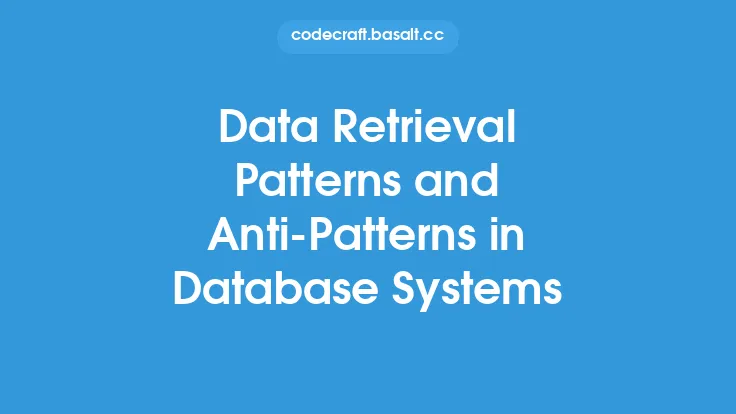Data retrieval is a crucial aspect of database systems, enabling users to access and manipulate data stored in a database. It involves the use of various methods and algorithms to extract data from a database, and its efficiency can significantly impact the performance of an application. In this article, we will delve into the world of data retrieval methods and algorithms, exploring the different techniques used to retrieve data from a database.
Introduction to Data Retrieval Methods
Data retrieval methods can be broadly classified into two categories: query-based and navigation-based. Query-based methods involve the use of a query language, such as SQL, to specify the data to be retrieved. Navigation-based methods, on the other hand, involve traversing the database to locate the desired data. Query-based methods are generally more efficient and flexible, as they allow users to specify complex queries and retrieve data in a variety of formats.
Query Optimization Techniques
Query optimization is a critical aspect of data retrieval, as it can significantly impact the performance of an application. There are several query optimization techniques that can be used to improve the efficiency of data retrieval, including indexing, caching, and query rewriting. Indexing involves creating a data structure that allows the database to quickly locate specific data, while caching involves storing frequently accessed data in memory to reduce the number of database queries. Query rewriting involves rewriting a query to make it more efficient, such as by reducing the number of joins or subqueries.
Data Retrieval Algorithms
There are several data retrieval algorithms that can be used to retrieve data from a database, including the B-tree algorithm, the hash table algorithm, and the graph traversal algorithm. The B-tree algorithm is a self-balancing search tree algorithm that is commonly used in databases to index data. The hash table algorithm is a data structure that maps keys to values using a hash function, and is often used to retrieve data quickly. The graph traversal algorithm is used to traverse a graph data structure, and is often used in databases that store complex relationships between data.
Indexing Methods
Indexing is a critical aspect of data retrieval, as it can significantly improve the efficiency of queries. There are several indexing methods that can be used, including B-tree indexing, hash indexing, and full-text indexing. B-tree indexing is a self-balancing search tree algorithm that is commonly used in databases to index data. Hash indexing is a data structure that maps keys to values using a hash function, and is often used to retrieve data quickly. Full-text indexing is used to index large amounts of text data, and is often used in databases that store documents or other text-based data.
Data Retrieval in Distributed Database Systems
Distributed database systems are databases that are spread across multiple physical locations, and can be accessed by multiple users. Data retrieval in distributed database systems can be more complex than in traditional databases, as it requires the coordination of multiple nodes to retrieve data. There are several algorithms that can be used to retrieve data in distributed database systems, including the distributed hash table algorithm and the peer-to-peer algorithm. The distributed hash table algorithm is a data structure that maps keys to values using a hash function, and is often used to retrieve data quickly in distributed database systems. The peer-to-peer algorithm is used to retrieve data from multiple nodes in a distributed database system, and is often used in systems that require high availability and scalability.
Data Retrieval in NoSQL Database Systems
NoSQL database systems are databases that do not use the traditional table-based relational model, and are often used to store large amounts of unstructured or semi-structured data. Data retrieval in NoSQL database systems can be more complex than in traditional databases, as it requires the use of specialized query languages and data models. There are several data retrieval algorithms that can be used in NoSQL database systems, including the document-oriented algorithm and the key-value algorithm. The document-oriented algorithm is used to retrieve data from document-oriented databases, such as MongoDB, and is often used to retrieve data in JSON or XML format. The key-value algorithm is used to retrieve data from key-value databases, such as Riak, and is often used to retrieve data quickly and efficiently.
Conclusion
In conclusion, data retrieval is a critical aspect of database systems, and its efficiency can significantly impact the performance of an application. There are several data retrieval methods and algorithms that can be used to retrieve data from a database, including query-based and navigation-based methods, query optimization techniques, and indexing methods. Distributed database systems and NoSQL database systems require specialized data retrieval algorithms and techniques, and can be more complex to implement than traditional databases. By understanding the different data retrieval methods and algorithms available, developers can design and implement efficient and scalable database systems that meet the needs of their applications.





